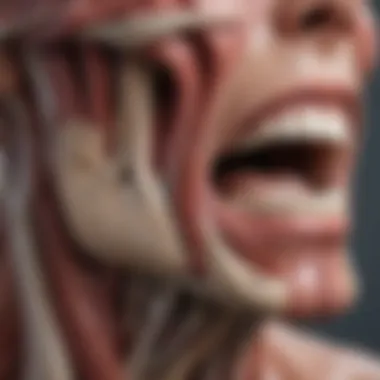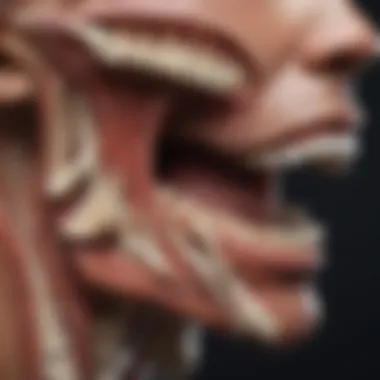Exploring the Muscles of the Temporomandibular Joint


Research Context
Background Information
The muscles involved in the temporomandibular joint (TMJ) form a complex network crucial for masticatory function. This joint, often overlooked in discussions about human anatomy, plays a pivotal role in our ability to chew, speak, and express emotions through facial movements. Understanding the anatomy of TMJ muscles is not just an academic task; it's a gateway to comprehending various physiological functions and the potential for disorders that can drastically affect quality of life.
When we think about jaw movement, several key muscles come to mind—such as the masseter, temporalis, and pterygoids. These muscles work in tandem to allow for various types of movement, including elevation, depression, and lateral translation of the mandible. Delving deep into the musculature around the TMJ provides insight into how even slight anatomical variations can lead to significant functional differences.
Importance of the Study
Recognizing the importance of TMJ musculature extends beyond anatomical curiosity. Disorders related to the TMJ, commonly referred to as TMJ disorders, can manifest as pain, restricted movement, and other complications that extend beyond the jaw itself, affecting daily life. For students and professionals in health sciences, understanding the detailed anatomy and functionality of these muscles becomes crucial.
Moreover, therapeutic considerations based on a thorough grasp of the TMJ anatomy can lead to more effective treatments for conditions such as bruxism, jaw dislocation, and even headaches. In a world increasingly characterized by stress-related jaw issues, this study is more relevant than ever, laying the groundwork for improved patient outcomes through comprehensive knowledge.
Discussion
Interpretation of Results
By analyzing the functions and interactions of the TMJ muscles, we arrive at a nuanced understanding of how they coordinate to facilitate not just basic chewing but also complex verbal communication. For instance, the masseter provides the primary force for elevating the jaw, while the pterygoids allow for intricate lateral movements essential for grinding food. Each muscle has distinct functional roles; their harmonious activity is vital for effective jaw function.
Comparison with Previous Research
Past investigations into TMJ muscles and their disorders have often focused narrowly on specific muscle groups or isolated symptoms. However, recent studies have expanded this understanding to include the interplay between these muscles and surrounding structures, including neurovascular supply. The significance of neurovascular connections is paramount, as it sets the stage for diagnosing conditions that may initially present as simple jaw pain but stem from more complex issues.
Additionally, contrasting the findings of recent studies with those from previous decades highlights an evolving understanding of TMJ functionality, bridging the gap between traditional anatomy and modern functional biomechanics. By situating current findings within this broader context, we can appreciate the advancements made in TMJ research while identifying areas that still require exploration.
"A thorough understanding of TMJ anatomy not only informs treatment strategies but also enriches our comprehension of human physiology as a whole."
In summary, a detailed examination of the muscles of the temporomandibular joint presents an invaluable opportunity for students, researchers, and health professionals to deepen their understanding of both anatomy and functionality, with implications that resonate through clinical practice and everyday health challenges.
Preamble to the Temporomandibular Joint
The temporomandibular joint (TMJ) is not just another joint in the body; it is a complex structure that plays a pivotal role in essential functions like speaking, eating, and even breathing. Understanding the TMJ’s anatomy and functionality is crucial for medical professionals and researchers alike, as this joint can be the source of various disorders that affect the quality of life. Heightened interest in TMJ function comes not only from its mechanical purpose but also from its contributions to overall health and wellbeing. When one thinks of joint movement, it’s easy to overlook the intricate relationships between muscles, bones, and the nervous system. However, a more in-depth view reveals that the muscles associated with the TMJ are central to its functionality.
Overview of TMJ
In simple terms, the temporomandibular joint is where the lower jawbone, or mandible, meets the temporal bone of the skull. This area allows for a wide range of motion, including opening and closing the mouth, side-to-side movement, and forward-and-backward adjustments. The TMJ consists of cartilage, ligaments, and the articular disc, which aid in cushioning and stabilizing the joint during movement. Just as a car engine relies on various components to run smoothly, the TMJ relies heavily on its anatomical features to function well.
From a clinical standpoint, any issues with these components—be it arthritis, dislocation, or muscular dysfunction—can lead to pain and restricted movement. This can frustrate even the simplest of actions, such as chewing food or articulating words clearly.
Importance of Muscles in TMJ Function
The muscles attached to the TMJ, namely the masseter, temporalis, medial pterygoid, and lateral pterygoid, serve invaluable purposes beyond mere movement of the jaw. These muscles provide the necessary strength and control required for complex functions like biting and grinding food. Each muscle should be viewed not merely as a unit, but as part of a larger system that enables the jaw to operate harmoniously.
- Masseter Muscle: The masseter is crucial for elevating the mandible, making it a primary muscle for chewing.
- Temporalis Muscle: This fan-shaped muscle aids in both elevation and retraction of the mandible, allowing for a more refined bite.
- Medial Pterygoid Muscle: It works in concert with the masseter to elevate the mandible and contributes to the side-to-side movements necessary for grinding.
- Lateral Pterygoid Muscle: Functions to move the jaw forward and down, playing a critical role in opening the mouth.
This seamless interaction among the muscles is necessary for effective jaw function. Dysfunction in one muscle can lead to compensatory mechanisms in others, which may create further issues over time.
The performance of TMJ-related muscles is essential not just for movement, but for the overall harmony and health of the oral cavity and associated structures.
Anatomy of the TMJ
Understanding the anatomy of the temporomandibular joint (TMJ) is paramount in grasping its functionality and the overall mechanics of jaw movement. The TMJ is not just an ordinary joint; it acts as the connecting link between the lower jaw (mandible) and the skull. This intricately designed joint is vital for various functions, including chewing, speaking, and even breathing. Having a comprehensive knowledge of the TMJ's anatomy contributes greatly to diagnosing disorders and developing treatment plans.
Structural Components of TMJ
The structural makeup of the TMJ comprises several key elements that work together seamlessly. These include:
- Mandibular Condyle: This rounded end of the mandible fits into the skull at the temporal bone, allowing for rotation and translation.
- Temporal Bone: The area of the skull that forms the sides and base where the mandibular condyle sits.
- Articular Disc: A fibrocartilaginous cushion that sits between the condyle and temporal bone, playing a crucial role in shock absorption and joint stability.
- Joint Capsule: A fibrous sheath that surrounds the TMJ, reinforcing its stability and containing synovial fluid which lubricates the joint.
Each component is designed intricately to ensure that the TMJ remains well-functioning, providing necessary support and movement. A slight alteration or damage to any of these elements can lead to significant dysfunction, hence why understanding these components is so vital.
Articular Disc and its Significance
The articular disc is not just a passive structure; it plays a pivotal role in the function and integrity of the TMJ. This oval-shaped fibrocartilaginous disc adapts with every movement of the jaw. Here are some of its critical functions:
- Shock Absorption: It cushions the impact from chewing and other jaw movements, reducing stress on the bones and preventing wear and tear.
- Improved Fit: The disc creates a smoother articulation surface and improves the congruence between the mandibular condyle and temporal bone, enhancing mobility.
- Facilitating Movement: It allows for complex movements of the jaw such as rotation and translation, which are important for effective chewing and speaking.


Without a proper-functioning articular disc, the jaw could experience issues such as clicking or locking, which are common complaints among those with TMJ disorders. Thus, recognizing the significance of this structure is crucial for both clinical evaluation and therapeutic interventions.
"The articular disc is essential not just for movement, but for maintaining the balance between functionality and the longevity of the joint."
In summary, the anatomy of the TMJ is a complex interplay of structures that enable essential jaw functions. A deep dive into its components, especially the articular disc, reveals the intricate mechanisms that support a healthy temporomandibular joint. Understanding these aspects is critical for effectively addressing any dysfunction that may arise.
Muscles Involved in TMJ Movement
The muscles that are tied to the temporomandibular joint (TMJ) play a crucial role in jaw movement and function. Understanding these muscles is essential for grasping how the TMJ operates and the impact of any dysfunction. Each muscle is uniquely positioned to facilitate movement in specific directions, allowing for complex actions like chewing, speaking, and even swallowing. Without these muscles working in tandem, everyday activities could become quite challenging, leading to potential discomfort or impairment.
Highlighting the functionality of these muscles provides insight into various conditions that may arise when they don't function correctly. For instance, overactivity or underactivity of the muscles can lead to disorders that affect not just the jaw, but overall craniofacial health as well. Recognizing the benefits and significance of maintaining proper muscular health around the TMJ is paramount, pointing towards preventive approaches in clinical practices.
Masseter Muscle
The masseter muscle is often regarded as the powerhouse of mastication. This robust muscle runs from the zygomatic arch to the lower jaw, and its primary action is elevation of the mandible. When one bites down, the masseter contracts greatly, generating the force necessary for effective chewing.
In addition, the masseter is composed of two distinct parts—the superficial and deep portions—each contributing differently to jaw mechanics. The superficial part is more powerful, providing substantial bite force, while the deeper portion aids precision movements. An interesting facet of the masseter is its ability to become hypertonic in cases of stress or bruxism, which can lead to muscle fatigue and discomfort.
Temporalis Muscle
Located on the lateral aspect of the skull, the temporalis muscle also contributes significantly to TMJ movement. With its fan-like shape, it originates from the temporal fossa and attaches to the coronoid process of the mandible. Its primary function is to facilitate elevation of the mandible, similar to the masseter muscle, but it also plays a role in retracting the mandible during chewing.
This muscle is unique owing to its intricate fibers that allow for versatile motion, adapting to various eating habits and styles. A well-conditioned temporalis muscle can help in distributing forces evenly across the jaw without causing undue stress to the joint itself. An imbalance here, like tightness or weakness, can lead to problems such as headaches or referred pain.
Medial Pterygoid Muscle
The medial pterygoid muscle serves as a flexible counterpart to the masseter. It’s a thick muscle located on the inner side of the mandible, working in synergy with other jaw muscles to facilitate movements. This muscle primarily aids in the elevation and protrusion of the mandible but is also key to the complex lateral movements required during chewing.
This muscle, when functioning optimally, contributes to the compressive forces on the jaw, distributing pressure and enhancing jaw joint stability. However, when overused or strained, it can contribute to myofascial pain syndromes. Proper evaluation and relaxation techniques may address discomfort originating from this muscle, illustrating its importance in jaw health.
Lateral Pterygoid Muscle
The lateral pterygoid is perhaps the most dynamic muscle associated with the TMJ. It has two heads—superior and inferior—allowing for the manipulation of the jaw in multiple directions. Its primary role is to facilitate depression and protraction of the mandible. This muscle is crucial for initiating mouth opening and enables lateral excursions, essential activities for effective chewing and speech.
Interestingly, dysfunction in the lateral pterygoid is often linked with symptoms relating to TMJ disorders. Those experiencing pain might realize sensations during movements, leading to clicking or popping sounds in the joint. Understanding the role of this muscle could therefore assist healthcare professionals in developing tailored interventions that restore functional health in patients.
Muscle Mechanics and TMJ Functionality
Understanding how muscles operate within the temporomandibular joint (TMJ) is crucial for both recognizing its normal function and diagnosing disorders. Muscle mechanics refer to the intricate interactions between the muscle groups that allow for various jaw movements. These mechanics not only influence the biomechanics of the TMJ but also hold significant implications for overall oral health.
Roles in Elevation and Depression
Muscle roles in the elevation and depression of the jaw encapsulate a fundamental aspect of temporomandibular function. Elevation refers to the upward movement of the mandible, crucial for actions such as chewing and speaking. The primary muscles responsible for this elevation include the masseter, temporalis, and medial pterygoid. Each muscle contributes uniquely:
- Masseter Muscle: This muscle is like a powerhouse. Its thick fibers allow for strong upward force, making it vital when biting or chewing tough foods.
- Temporalis Muscle: With its fan-shaped design, the temporalis provides a substantial vertical force during biting. Additionally, its posterior fibers play a role in retracting the jaw, helping with grinding actions.
- Medial Pterygoid Muscle: Although often overshadowed by its fellow muscles, the medial pterygoid works in conjunction with the masseter, creating a solid foundation for jaw elevation.
On the flip side, the depression of the mandible is largely governed by the lateral pterygoid muscle. This muscle pulls the mandible down, allowing the jaw to open.
Key Point: The balance and coordination between these muscles allow for fluid and efficient movement, preventing strain and potential dysfunction.
These movements are not merely mechanical; they implicate sensory feedback systems that signal the brain about jaw position and motion, which is vital for maintaining oral health.
Lateral Movement Mechanics
Whenever you think about lateral movements of the jaw, the lateral pterygoid is the real star of the show. It enables side-to-side movements, which are crucial for grinding food and facilitating proper oral function. This muscle works almost like a seesaw, creating a coordinated motion between left and right sides. Its role in lateral excursion cannot be overstated.
Secondary players include the muscles that assist in stabilizing and guiding the mandible:
- Medial Pterygoid Muscle: In lateral movement, this muscle on the opposite side acts to help stabilize and control the movement.
- Temporalis Muscle: It assists with retraction as it helps counterbalance the forces generated during lateral movement.
Despite these intricate mechanics, issues can arise. When there’s a disparity in strength or coordination among these muscles, it can lead to complications such as TMJ disorders. This highlights the need for a deeper understanding of muscle mechanics when dealing with jaw-related issues, particularly for health professionals.
In summary, the mechanics of muscle action are integral to the TMJ's functionality and its overall health. An imbalance or dysfunction in any of these muscles can lead to pain, restricted movement, and other complications that significantly affect quality of life.
Neurovascular Supply to the Muscles
Understanding the neurovascular supply to the muscles surrounding the temporomandibular joint (TMJ) is crucial in grasping how these muscles perform their roles in facilitating jaw movements. The proper functioning of these muscles relies heavily on their innervation and blood supply. Without adequate nerve input and blood flow, even the strongest muscles would struggle to operate efficiently during activities like chewing or speaking.


The muscles associated with the TMJ, such as the masseter, temporalis, and pterygoid muscles, require precise neural control for movement coordination. Dysfunction in this area can lead to myriad problems, from pain to impaired jaw mobility. Therefore, understanding the neurovascular architecture can help in diagnosing and treating TMJ-related disorders effectively.
Nerve Innervation of TMJ Muscles
The innervation of TMJ muscles primarily comes from branches of the mandibular nerve, specifically the trigeminal nerve (CN V). The masseter muscle is innervated by the masseteric nerve, a branch of the mandibular nerve, facilitating powerful contraction for jaw elevation.
Similarly, the temporalis muscle receives its innervation through the deep temporal nerves. This specific nerve distribution allows for complex, integrated movements. The pterygoid muscles also benefit from the branches of the mandibular nerve, enabling side-to-side motions essential for grinding food.
"Understanding the nerve pathways is essential not only for muscle function but also for pinpointing the causes of various TMJ disorders."
An effective neuromuscular communication system is vital. Disruptions in the nerve supply can lead to conditions such as bruxism. Which is often characterized by teeth grinding and TMJ dysfunction.
Blood Supply Overview
Muscles surrounding the TMJ receive their blood supply primarily from branches of the maxillary artery, which plays a pivotal role in delivering nutrients and oxygen to these tissues. The maxillary artery itself branches into several important arteries:
- Inferior alveolar artery: supplies the masseter and other nearby muscles.
- Deep temporal arteries: nourish the temporalis muscle.
- Pterygoid branches: responsible for vascularizing the pterygoid muscles.
This robust arterial network ensures that the TMJ muscles are adequately nourished, allowing them to function effectively. Impaired blood flow, whether from vascular disease or injury, can lead to muscle fatigue and reduced jaw function, further complicating any existing TMJ issues.
In summary, the integration of nerve innervation and blood supply forms the backbone of muscle functionality in the TMJ. Acknowledging the significance of these neurovascular elements provides a clearer framework for studying TMJ disorders and their management.
Common Disorders Affecting TMJ Muscles
Understanding common disorders affecting the muscles around the temporomandibular joint (TMJ) is crucial for grasping the complexities of jaw functionality and health. The significance of this topic ties into various aspects, from the intricate balance of muscle movements to the painful repercussions of dysfunction. Muscle disorders impact not only how we chew and speak but also our overall quality of life. Delving into these conditions helps identify how they influence daily activities, patient management, and treatment strategies.
Temporomandibular Disorder (TMD)
Temporomandibular Disorder, often abbreviated as TMD, encompasses a range of issues related to the TMJ and its associated muscles. Individuals suffering from TMD might experience a cocktail of symptoms, including jaw pain, difficulty in opening the mouth, and clicking or popping sounds during jaw movement. This condition can stem from a myriad of factors such as stress-induced muscle tension, injury, or misalignment of the jaw.
The diagnosis of TMD often involves a comprehensive physical examination, where the clinician checks the jaw for tenderness, range of motion, and any abnormal sounds. Treatment modalities can vary, ranging from conservative approaches like physical therapy and oral splints to more invasive measures such as surgery in severe cases.
Understanding TMD is not just about the symptoms; it’s also about addressing the underlying causes to restore function and alleviate discomfort.
Bruxism and its Impact
Bruxism refers to the involuntary grinding or clenching of teeth, commonly occurring during sleep or in response to stress. This condition is often a silent tormentor, leading to serious repercussions like tooth wear, jaw discomfort, and headaches. In many cases, bruxism is linked to TMD, as the muscles involved are constantly overworked, leading to fatigue and pain.
The impact of bruxism extends beyond just the muscles; it can also exacerbate other TMJ disorders, creating a vicious cycle of pain and dysfunction. Often, awareness is the key to managing bruxism. Patients may benefit from strategies such as stress management techniques, custom dental guards, and adjustments in lifestyle to mitigate the effects. Addressing bruxism is vital to preserving both dental and muscular health in individuals.
Myofascial Pain Syndrome
Myofascial Pain Syndrome (MPS) is characterized by the presence of trigger points in the muscles surrounding the TMJ. These trigger points can be tender to the touch and may refer pain to other areas, complicating the clinical picture. People with MPS often report a deep, aching discomfort that seems to stem from their jaw muscles but might affect surrounding areas like the neck and shoulders.
The management of MPS typically includes physical therapy, trigger point injections, and the implementation of stretching and relaxation techniques. The overall goal here is to reduce pain and restore mobility, allowing for improved function of the TMJ and its associated muscles. It’s essential to approach MPS with a tailored strategy that addresses both the localized pain and any potential contributing factors, like stress or poor posture.
Assessment Techniques for TMJ Dysfunction
The evaluation of temporomandibular joint (TMJ) dysfunction stands as a pivotal aspect in both diagnosis and treatment planning for individuals suffering from these conditions. By employing effective assessment techniques, healthcare providers can pinpoint the source and extent of dysfunction, guiding them toward tailored interventions that alleviate pain and optimize jaw functionality. This section delves into two specific areas that considerably benefit the assessment process: clinical examination protocols and diagnostic imaging applications.
Clinical Examination Protocols
A clinical examination serves as the cornerstone of any TMJ dysfunction assessment. During this evaluation, practitioners observe and palpate the joint for specific indicators of dysfunction. The primary goal is to note any abnormal symptoms like clicking, popping, or limited range of motion. Key components of this protocol can include:
- History Taking: Gathering comprehensive patient medical history is vital. This includes exploring the onset of symptoms, duration, and any exacerbating factors. Knowing whether the patient grinds their teeth or experiences jaw clenching can provide insights.
- Visual Inspection: A careful observation of the jaw's movement can reveal asymmetries or deviations that signal potential problems. The provider may assess both active and passive movements, looking for discrepancies.
- Palpation Techniques: By palpating the masseter and temporalis muscles, the clinician can identify areas of tenderness. Palpation of the TMJ itself helps to uncover any inherent dysfunction.
- Functional Assessments: Simple tasks, like opening and closing the mouth, chewing, or even speaking, can be monitored. Any pain or limited ability during these activities can further inform the assessment.
By utilizing these protocols, clinicians can build a clear picture of the patient's condition, laying the groundwork for further evaluation and effective treatment.
Diagnostic Imaging Applications
While clinical examination provides substantial information, diagnostic imaging enhances the evaluative process. Through advanced imaging techniques, health professionals can visualize the joint's internal structure, offering insights that might not be apparent through physical examination alone. Common imaging methods include:
- X-rays: These are typically the first line of imaging to assess joint structure and rule out fractures. Although X-rays may not show soft tissues well, they can highlight bone changes related to TMJ arthritis.
- Magnetic Resonance Imaging (MRI): This approach shines a light on soft tissue anatomy. It is useful for viewing the articular disc, ligaments, and muscles surrounding the TMJ. MRIs can help in diagnosing derangements or disc displacement.
- Computed Tomography (CT): This imaging is ideal for a more detailed examination of bony structures around the joint. CT scans allow practitioners to see the orientation and any degenerative changes affecting the joint.
Integrating these imaging applications into assessments allows for a comprehensive evaluation of TMJ conditions, leading to more accurate diagnosis and treatment planning. The confluence of clinical findings and imaging results helps form a solid framework for understanding individual patient needs.
In summary, effective assessment techniques for TMJ dysfunction hinge on a combination of thorough clinical protocols and advanced imaging methods, which together enhance the diagnostic accuracy and treatment outcomes.


Treatment and Management of TMJ Disorders
Addressing disorders related to the temporomandibular joint (TMJ) involves a multifaceted approach to treatment and management. This section emphasizes the importance of recognizing the complexities of TMJ dysfunction, which can stem from a variety of sources including muscle strain, joint issues, or systemic conditions. Proper management not only alleviates symptoms but also enhances overall quality of life. By understanding the different treatment modalities available, practitioners can provide tailored care that meets individual patient needs.
Physical Therapy Approaches
Physical therapy stands as a cornerstone in treating TMJ disorders. Unlike a one-size-fits-all solution, this method focuses on targeted exercises designed to strengthen the muscles surrounding the joint. Here are some key approaches:
- Jaw Exercises: Specific exercises can help retrain jaw function, reduce stiffness, and improve range of motion. For instance, gentle stretching and lateral movement exercises can allow the patient to regain more normal function.
- Manual Therapy: Techniques like myofascial release may relieve muscle tension around the TMJ. A skilled therapist might use specialized hand techniques to manipulate and stretch the affected areas.
- Education on Posture: Often overlooked, posture plays a significant role in TMJ disorders. Physical therapists can guide patients on neck and jaw positioning to prevent exacerbatiion of symptoms.
The ultimate goal of physical therapy is to provide patients with tools to manage their condition actively, decreasing the reliance on medications or invasive interventions.
Pharmacological Interventions
When physical therapy alone does not suffice, pharmacological treatments become vital. Various medications can help reduce inflammation, alleviate pain, and improve joint function. Consider the following options:
- Nonsteroidal Anti-Inflammatory Drugs (NSAIDs): Over-the-counter options like ibuprofen can be effective in managing discomfort.
- Muscle Relaxants: These can help reduce muscle spasms in cases where tension is contributing to TMJ issues.
- Corticosteroids: In some situations, a doctor may recommend corticosteroid injections directly into the joint to provide rapid inflammation relief.
Using pharmacological interventions in conjunction with other therapies can create a well-rounded approach to managing TMJ disorders effectively. Each patient responds differently, and careful monitoring by healthcare professionals is essential to mitigate potential side effects.
Surgical Considerations
Though often seen as a last resort, surgical interventions may be necessary for certain severe or persistent TMJ disorders. Surgery could be recommended when other treatments fail to provide relief or if there are significant structural problems in the joint itself. Key surgical options include:
- Arthrocentesis: A minimally invasive procedure involving the washing out of the joint to clear debris and reduce inflammation.
- Open Joint Surgery: Indicated in cases of dislocation or severe arthritic changes, allowing direct access to the joint for repair or stabilization.
- Orthognathic Surgery: This procedure addresses underlying skeletal issues that could be impacting the function of the TMJ.
Before proceeding with surgical options, it is imperative to weigh the risks versus benefits, and to exhaust non-invasive methods as part of a comprehensive treatment plan.
Effective management of TMJ disorders combines various approaches tailored to individual patient needs, ensuring a careful consideration of both the physical and psychological aspects of care.
Future Directions in TMJ Research
Research into the temporomandibular joint (TMJ) isn't just about solving today's problems; it’s about laying the groundwork for a future where jaw health is taken seriously. As we delve into this field, the need for innovative perspectives and methodologies becomes glaringly apparent. The ongoing evolution of medical science necessitates an examination of emerging therapies and interdisciplinary approaches which hold the potential to revolutionize our understanding and treatment of TMJ-related issues.
Exploring future directions in TMJ research is vital for several reasons:
- Better Patient Outcomes: Advances in treatment strategies—whether through improved physical therapy protocols or novel pharmacological options—can lead to more effective management of TMJ disorders.
- Understanding Mechanisms: Unraveling the biological and mechanical processes involved in TMJ function will provide insights into developing preventative measures.
- Interconnectedness of Disciplines: Combining knowledge from various fields can enhance the diagnostic and therapeutic landscape for TMJ disorders, leading to comprehensive patient care.
Emerging Therapies
The notion of emerging therapies for TMJ disorders offers a lot of hope for patients seeking relief from persistent pain and dysfunction. Traditionally, treatment options were limited, focusing mainly on physical therapy or medications. However, recent trends suggest that we could soon see a wide array of therapies that include:
- Regenerative Medicine: This could encompass platelet-rich plasma (PRP) injections, which aim to enhance healing through the body's natural processes.
- Bioelectronic Medicine: Neuromodulation devices could be used to manage pain signals, addressing TMJ-related discomfort at its source.
- Behavioral Therapies: Integrating psychotherapy with physical therapies can help manage the psychological stresses that often accompany chronic TMJ pain.
These therapies, while still being tested, show a promising horizon that could transform care approaches and empower patients.
Interdisciplinary Approaches in TMJ Studies
To tackle the complex issues surrounding TMJ disorders, interdisciplinary approaches are critical. This means that addressing the multifaceted nature of TMJ problems—biological, psychological, and social—requires collaboration across various disciplines, including:
- Dentistry and Orthodontics: Working together to understand occlusion and its impact on TMJ health is fundamental.
- Physiotherapy and Rehabilitation: Collaboration with movement specialists can refine therapy protocols and enhance recovery.
- Psychology and Counseling: Engaging with mental health professionals can provide insights into behavioral changes and coping strategies for patients.
- Pain Management Experts: By working alongside pain management specialists, we can better address the chronic pain that often accompanies TMJ disorders.
"Integrative approaches not only pave the way for tailored treatments but also enhance our understanding of the underlying pathophysiology of TMJ disorders."
In sum, the future of TMJ research is chock-full of promise. By pursuing emerging therapies and adopting interdisciplinary approaches, we can create a more comprehensive view of TMJ health, ultimately informing better practices and improved quality of life for those affected.
Finale on TMJ Muscle Functionality
Comprehending the functionality of the muscles associated with the temporomandibular joint (TMJ) is pivotal for a holistic view of jaw mechanics and overall craniofacial health. The TMJ facilitates a myriad of movements essential for daily activities such as speaking, chewing, and swallowing. These movements rely heavily on the synchronized actions of the masseter, temporalis, medial pterygoid, and lateral pterygoid muscles.
An in-depth analysis reveals that dysfunction in these muscles can lead to significant repercussions, not only affecting jaw function but also impacting a person's quality of life. For instance, conditions like Temporomandibular Disorder (TMD) or bruxism exemplify how muscle inadequacy can spiral into widespread issues—resulting in chronic pain, headaches, and even psychological stress. Hence, understanding these muscles extends far beyond anatomy; it merges into realms of clinical significance, patient care, and research.
Summary of Key Points
- Anatomical Components: Familiarity with each muscle's structure and role is essential for recognizing how they contribute to TMJ functionality.
- Movement Mechanics: Proper engagement of the muscles allows for efficient jaw movement, crucial for oral health. Misalignment or overuse can lead to disorders.
- Impacts of Dysfunction: TMD, bruxism, and myofascial pain syndrome showcase the broad implications of muscle health on well-being.
- Assessment and Treatment: Early diagnosis and appropriate treatment strategies—ranging from physical therapy to pharmacological interventions—can mitigate long-term consequences.
"A sound understanding of TMJ muscle functionality isn't just academic; it holds real-world implications for patient health and treatment outcomes."
Implications for Future Research
The domain surrounding TMJ muscles is ripe for exploration and advancement. As healthcare progresses, so too must our understanding of the interactions among muscle dynamics, neural pathways, and vascular supply. Future research can explore several critical avenues:
- Advanced Imaging Techniques: Utilization of technologies like MRI and CT scans can provide greater insights into muscle behavior during various jaw functions.
- Biomarkers for Dysfunction: Identifying biological markers related to TMJ disorders can help in early diagnosis and tailored treatments.
- Multidisciplinary Approaches: Investigating TMJ functionality through perspectives that include dentistry, physiotherapy, and neurology can foster comprehensive treatment paradigms.
- Technological Innovations in Treatment: Exploring new therapeutic options such as biofeedback training or regenerative medicine may significantly enhance management strategies for TMJ disorders.
By prioritizing these research directions, the community can unearth knowledge that not only enhances our understanding but also directly influences clinical practices and patient experiences related to TMJ functionality.















